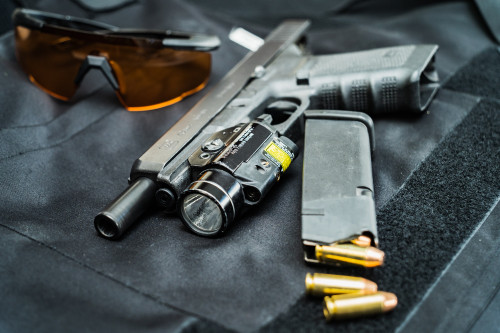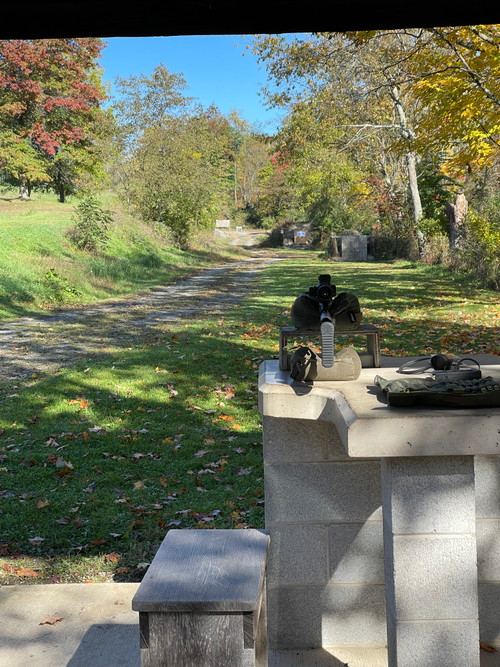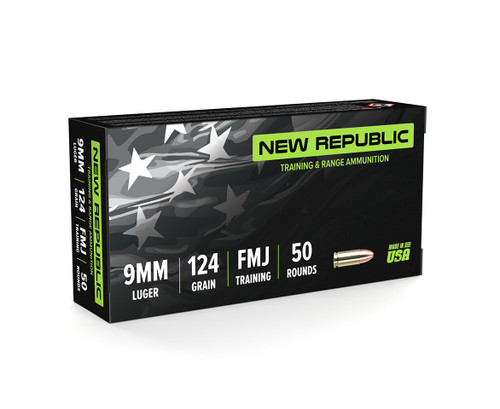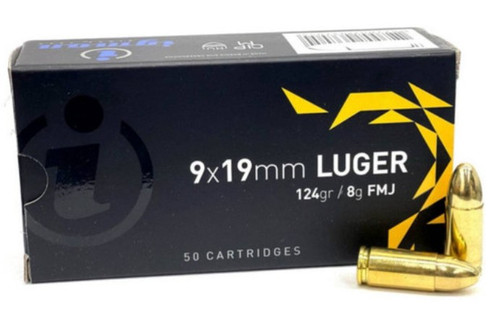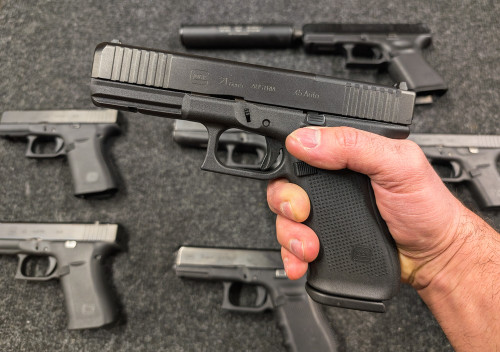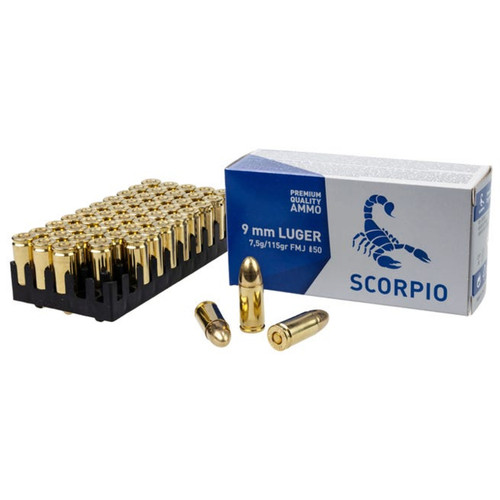The ability to defend yourself against an aggressor is the inherent right of every American, especially on private property. After all, there’s no place where you should be safer than inside your own home. That’s why many gun owners choose to arm themselves as part of their home defense plan.
Firearms are to home defense what the queen is to chess. They can strike from far away and have the power to deter even the most formidable opponents. If you don’t have a queen on the board, you’re probably going to lose the game. Likewise, if you have a firearm, you’re infinitely better off against a home invasion than if you don’t.
But not every gun is suitable for home defense. Choosing the right home defense gun is important for the safety of yourself, your family, and your neighbors. Plus, an intruder could come knocking (or not) at any time, so it's important to be armed with a weapon that has the right amount of power and design for your needs.
Let’s break down what to look for in a home defense gun to help you make a better decision. We’ll even share some of our favorite picks from the team of veterans here at Pro Armory.
Legal Considerations for Defending Yourself
Remember that different jurisdictions and different states all have different laws regarding your right to self defense. Some variables to consider include:
- Defending Yourself vs Your Property: Regardless of where you live, you can use deadly force to defend yourself from death or serious bodily harm. However, the vast majority of states don’t allow you to defend your property with deadly force. In other words, you can’t mag-dump into a thief if they’re just trying to steal your car without threatening you.
- Location: Some states allow you to use deadly force to defend yourself anywhere on your property (like in your yard or driveway). Others only allow this when you’re physically within your home.
- Duty to Retreat: Certain laws require a potential victim to attempt fleeing a situation before they can use deadly force.
- Building an AR (Or Any Gun) - An AR-15 is a common (but maybe not the best) self-defense gun. It also lends itself well to customization. However, if you choose to build your own AR or any self-defense firearm, be wary that if you ever end up in court for firing a shot at an intruder, it will be harder to defend your case than if you had simply bought the firearm from a licensed dealer. If you’re going with an AR for home defense, it’s probably better to buy than to build.
Over-Penetration: The Problem With Rifles
Home defense scenarios happen at extremely close ranges — sometimes within just a few feet. As a result, any weapon designed for longer ranges can present a problem: over-penetration.
Over-penetration is when a bullet passes through a target and into something behind it. This is especially critical for apartment residents. It can happen with any caliber, but it’s largely dependent on velocity and bullet design. Cartridges like 5.56 NATO, 9mm, .45 ACP, 7.62, etc. might go through six walls and keep going if you’re using FMJ. For this reason, you want to make sure you’re using hollow point rounds that expand well and move somewhat slower (+P rounds are not a good pick).
For this reason (and several others), some rifles don’t make particularly good home defense guns. You don’t want to over-penetrate a home invader with an M1 Garand and send a 30-06 bullet sailing into your neighbor’s refrigerator.
That said, some rifles can make good home defense guns. Both the AR and AK patterns are good for this application (preferably with shorter barrels for tactical effectiveness). Likewise, over-penetration isn’t a phenomenon that’s exclusive to rifles. Some particularly powerful handguns can also over-penetrate (.357 Magnum for instance).
Home Defense Shotguns
Shotguns are some of the best firearms out there for home defense. They’re easy to fire quickly, and you don’t need a ton of training to use one effectively at shorter ranges.
Pro Tip: If you’re using a shotgun for home defense, make sure you pick one with as short a barrel as possible (18 inches is the shortest allowed under federal law, but your state’s rules may vary).
If you go with a shotgun, you’ll need to pick between semi-auto and pump-action. Semi-auto shotguns fire every time you pull the trigger, automatically cycling the weapon. Meanwhile pump shotguns require the operator to manually cycle the empty cartridge before firing again. Make sure you pump fully forward and back to ensure you eject the empty cartridge.
A shotgun is one of the best choices for a home defense gun, but it has its drawbacks. Here’s a look at the pros and cons:
| Pros | Cons |
|---|---|
| Easier to hit targets | Limited magazine capacity |
| Low chance of over-penetration | Limited rate of fire for some models |
| Can hit multiple targets | Can be unwieldy around corners |
| Short range |
Interested in going with a shotgun for home defense? 12-gauge is by far the best gauge for home defense, but 20-gauge is also acceptable. However, any gauge outside of these two picks (like the .410 for instance) is probably a bad idea.
Here are some of our favorite home defense shotguns, all chambered in 12-gauge:
Mossberg 500
Made in the USA, the Mossberg 500 is one of the kings of inexpensive shotguns. With a rugged and dependable design, these pump-action shotguns are some of the most popular on the market today. It can hold a maximum of six shells — five in its tube magazine, and one in the chamber. It’s also highly modular. Unlike some shotguns out there (like the Winchester SXP), you can easily swap barrel lengths on the Mossberg 500. That means you can use the same shotgun for both home defense and hunting.
Remington 870
The Remington 870 is one of the most prolific shotguns of all time. What’s behind that impressive legacy? Durability. To build the 870, Remington (now owned by private equity group Roundhill) mills down a single piece of solid steel to make the gun’s receiver.
If you decide to go with an 870 for your home defense shotgun, be aware that there’s more than one model available. Many of them are intended for bird hunting, so they have longer barrels. You’ll want to go with the Fieldmaster or the Special Purpose Marine Magnum. These both have 18-inch barrels, making them ideal for home defense.
Beretta A300 Ultima Patrol
Unlike the Mossberg 500 and Remington 870, the Beretta A300 Ultima Patrol is a semi-auto shotgun. This means that they can sustain a higher rate of fire than pump-action guns, and can clear out a room in seconds. This tactical shotgun also has a higher capacity than the others we’ve mentioned, maxing out at eight shells with a loaded chamber. It also has a 19-inch barrel, making it great for indoor use. The only downside to this firearm is its cost. Clocking in at just under $1,000, it’s nearly twice the cost of a Mossberg 500.
Shotgun Shell Types
Finally, you’ll want to consider which type of shotgun ammo you’ll use. Shotgun shells generally come in three flavors:
- Birdshot: Birdshot is not a good choice for home defense. It’s designed for creatures much smaller and less dense than humans (birds), and it lacks stopping power at medium ranges.
- Slugs: Not always a great choice for home defense, since they can over-penetrate more than buckshot or birdshot.
- Buckshot: Great for home defense, since they’re more powerful than birdshot but also unlikely to over-penetrate.
Some shotguns (like the pump-action Mossberg) can use minishells, designed to be half the size of a normal shell to increase the amount you can load at one time (while still packing a punch).
Pistols: Home Defense Handguns
Pistols present plenty of advantages for home defense applications. For one, they’re smaller than rifles. That means they’re easy to stow out of sight in a nightstand or small safe. They’re also some of the easiest weapons to use indoors. Going through doors and checking corners is much simpler with a pistol than with a long-barreled gun like a shotgun or PCC (more on those later). However, pistols do require the most training to use effectively.
| Pros | Cons |
|---|---|
| High mag capacities | Relatively hard to aim |
| Wide range of ammunition | Less stopping power than a shotgun |
| Medium range | Higher chance of over-penetration than shotguns |
| Usually features high rate of fire | |
| Easy to maneuver indoors |
If you’re thinking about a pistol for home defense, consider some of our favorites.
Glock 17
In many ways, the Glock 17 ushered in the era of the modern pistol. It was the first striker-fired polymer pistol to take off, and competitors have been doing their best to churn out “Glock-killers” ever since.
The Glock 17 is chambered in 9mm. As a full-size handgun, it’s a little bigger than its well-known cousin, the Glock 19. Its slightly longer sight radius also makes it a little easier to aim. It’s also thicker than the Glock 19, so it’s a good choice for anyone with big hands.
The only real problem with Glocks is their “mushy” trigger pull. However, Glock does sell performance triggers to rectify this.
Glock 19
Glock essentially invented the compact pistol when it introduced the Glock 19. Compressed into a slightly smaller package than the Glock 17, the 19 is a little bit easier to conceal. It’s also easier to hold if your hands aren’t beefy enough for the 17.
Like its larger cousin, the Glock 19 is chambered in 9x19mm. Both the 19 and 17 feature Glock’s proprietary safety mechanism built into the gun’s trigger. The lack of a dedicated safety may be off-putting for some gun newbies, this can be beneficial if you ever need to send lead downrange in a hurry. You don’t want to be fumbling with a manual safety while a threat closes in on you.
Sig Sauer P320
Remember how we mentioned “Glock killers” earlier? The P320 is the pistol that comes the closest to that description. Like the Glocks above, this gun is a striker-fired pistol with a polymer body chambered in 9x19mm. While it has several advantages over Glocks, it also has a few drawbacks.
One of the biggest benefits of the P320 series is its modularity. You can remove the fire control group of a P320 and place it in a different body, changing the size of components like the slide, barrel, and frame. This means you can essentially have a single gun that can be full-sized or compact depending on your needs. The P320 also has a better stock trigger than Glocks.
Fair warning, though: multiple police departments have filed lawsuits against Sig Sauer, saying that the P320 can go off on its own, without an operator pulling the trigger (sometimes hitting the operator). There’s currently a lawsuit going through the courts to determine whether this is a design flaw or operator error, but keep this in mind if you’re considering a P320. If this worries you, Sig does make P320s with manual safeties under the “M17” and “M18” monikers. Turn on the manual safety, and the gun can’t fire.
Smith & Wesson 686 Plus
The 686 Plus from Smith & Wesson is the only revolver that earned a spot on our list of the best home defense guns. That’s because this stainless steel monster is one of the best revolvers money can buy in today’s gun market.
Chambered in .357 magnum, the 686 Plus has one huge advantage over other revolvers. Instead of maxing out at six rounds, the 686 Plus can hold seven. All models can also fire .38 special cartridges, which sacrifice some penetrating power but seriously reduce recoil. This also helps combat over-penetration, making .38 special a great home defense round. The gun is also capable of both a single- or double-action trigger pull.
Taurus G3
A Brazilian company, Taurus cut its teeth making clones of Smith & Wesson and Ruger revolvers. However, over the last decade or so, they’ve begun producing their own original designs. The G3 is the result of Taurus’ research and development.
The G3 comes in several different sizes, including full-size and compact. Chambered in either 9x19mm or .40 S&W, the G3 usually has a 10-, 12-, or 17-round capacity. In many ways, it’s similar to the Glocks and P320s we covered above. For example, it’s striker-fired and has a polymer frame. It’s also cheaper than either of its competitors, and is popular among people who want to defend themselves without breaking the bank.
Beretta 92FS
If you’re a fan of the Lethal Weapon series, you’re probably already familiar with the Beretta 92FS. Riggs’ favorite sidearm is a full-sized pistol chambered in 9x19mm. The all-metal construction makes it a little heavier than the polymer guns on this list, which results in less recoil.
What really sets the 92FS apart though is its double-action/single-action trigger. After the first shot, it fires in single-action mode. This ends up giving the 92FS an extremely long trigger pull – noticeably longer than any other gun on this list (except for the 686 Plus). It may require a bit more training than the striker-fired “tupperware guns” on this list. But once you get it down, this gun operates smooth as butter.
Pistol Ammo Types
Here are some of the best pistol calibers you might use for home defense:
- 9x19mm: The notorious nine — a small round that combines low recoil with good stopping power. Many 9mm pistols feature double-stack magazines, giving them high capacity. 9mm ammo is also plentiful and thus cheap.
- .45 ACP: Often (but not always) associated with the 1911, this big, slow-moving, heavy bullet has high stopping power and a low chance of over-penetration. If you look at .45 ACP pistols that aren’t 1911s, they often have a magazine capacity that rivals 9mm.
- .40 Smith & Wesson: Originally designed for the FBI, the .40 Smith & Wesson (AKA 40 S&W) combines the manageable recoil of 9x19mm with the sheer power of 10mm. It isn’t as popular as 9x19mm or .45 ACP, but it’s still a valid home defense caliber.
- .380 ACP: With the .380’s manageable recoil and moderate stopping power, this round strikes a great balance between stopping power and control. You can find a wide range of .380 hollow point ammo, and many .380-chambered pistols are lightweight, making them easier to carry.
Regardless of which caliber you end up choosing for your pistol, you should be using hollow-point ammo for home defense. These rounds feature a cut in the nose of the bullet, which causes the bullet to expand after hitting the target. The end result is a bigger wound channel, increasing the round’s stopping power. Hollow points can also fragment within the target, preventing over-penetration.
In contrast, you may want to avoid “+P” ammunition for home defense. These rounds have extra powder for increased penetrating power. They’re useful against thick-skinned targets like bears, or for punching through concealment to hit a target. This is the opposite of your ideal home defense scenario, unless you’re planning on defending your home from a tank.
Pistol-Caliber Carbines (PCC)
One final type of firearm that may be a good choice for home defense is the relatively new kid on the block: pistol-caliber carbines (PCCs). These firearms are essentially rifles, but chambered in a pistol cartridge. This makes them easier to aim than pistols, since they have a stock to brace against your shoulder. They also have the same capacity as pistols, which gives the operator plenty of firepower against anything that goes bump in the night.
The only downside of PCCs for home defense is that they have longer barrels than regular pistols. This increases the overall energy of a bullet leaving the muzzle of the gun. As a result, PCCs are more prone to over-penetration than shotguns or pistols. However, you can overcome this issue by using hollow points.
| Pros | Cons |
|---|---|
| High mag capacities | Higher chance of over-penetration compared to pistols and shotguns |
| Wide variety of ammunition | Less stopping power than a shotgun |
| Medium range | Harder to aim than a shotgun |
| Usually features a high rate of fire | |
| Easier to aim than a pistol |
Do the combined advantages of a PCC strike your fancy? Here are some of our top picks. All of these firearms feature semi-auto actions along with a Picatinny 1913 rail for mounting optics and other accessories.
NOTE: PCCs use the same caliber cartridges as pistols (listed above), hence their name.
Ruger PC Carbine
Ruger is one of the most prolific gun manufacturers in the US. They have a reputation for making durable and functional guns without the frills that some other manufacturers add. The PC Carbine embodies this spirit, and is one of the best PCCs available today.
Chambered in either 9x19mm or .40 S&W, the PC Carbine usually has a 17-round capacity. Ruger also sells state compliant models with 10-round magazines. The firearm comes with interchangeable magwells so you can use either Ruger or Glock standard magazines.
Kel-Tec Sub 2000
There are plenty of memes on the internet about how the engineers at Kel-Tec are a bunch of mad scientists cooking up insane firearm designs. The Sub 2000 is one such insane design, but it’s also immensely practical.
Chambered in 9mm and 40 S&W, the Sub 2000 boasts one feature that no other gun on this list has: it can fold in half. That makes it significantly easier to stow in a backpack, under your bed, or in some other secret place. It can also accept magazines from many major pistol manufacturers, including Glock, Beretta, CZ, Smith & Wesson, and SIG Sauer. This gives it a huge advantage over other PCCs, and means its capacity can range anywhere from 10 to 33 rounds.
Aero EPC-9
There’s a reason the AR-15 is one of the most popular rifles in the world today. As a direct impingement firearm, it’s highly accurate. It also features very little recoil. It’s also extremely reliable — it’ll always go bang when you pull the trigger.
The Aero EPC-9 takes all of these advantages and puts them into a highly accurate 9mm PCC (with .40 variations available also). Starting out as an aerospace company, Tacoma-based Aero Precision has now broken into the PCC market. The EPC-9 is a pretty standard AR-9, with a few improvements that make it different. For instance, Aero decided to build the trigger guard into the lower receiver, and they installed more durable trigger pins in their unique fire control group. It also takes Glock mags, making it a versatile contender for self-defense guns, especially if you already have a 9mm Glock in your possession.
Palmetto State Armory AK-V
If you’re a fan of the rugged reliability of the AK platform, the Palmetto State Armory (PSA) AK-V might be your ideal home defense weapon. The gun is an AK in every regard except for one: caliber. While AKs normally fire 7.62x39 (with a few of them chambered in 5.45x39, the greatest cartridge known to man), the AK-V is chambered in 9x19mm. What’s more, it’s one of the few US-made AKs that are actually worth buying.
Unlike the PC Carbine, Sub 2000, and AR-9, the AK-V doesn’t take Glock mags. Instead, it uses specially built mags from PSA. These magazines only work with both the AK-V and the CZ Scorpion (another great PCC), so you won’t be able to interchange magazines between your guns. You can find these magazines in 35 and 50 rounds, along with 5- or 10-round limiters for those of us in states with capacity limits.
Choose the Right Home Defense Gun For You
By defending your home with a firearm, you’re making a decision. You’re choosing to be self-reliant and take an active role in your own defense. Whether you go with a pistol, shotgun, or PCC, you’re deciding not to be a victim.
You can read countless online reviews about the “best” gun, but at the end of the day the best weapon for home defense is the one you actually train with. The only way to truly know for yourself is to try out different guns on the range. Pay close attention to how a gun feels in your hand. How’s the grip angle? Is the recoil overwhelming? Research can only do so much before you need to roll up your sleeves and start sending lead downrange.
What’s more, you’ll want to make sure that your family is trained, too. If you’re married, that might mean taking your spouse out to a few range sessions with you. For kids, that might entail making sure they don’t touch your gun at all, or at least learning the basics of firearm safety.
Need to stock up on home defense protective gear and ammo to complement your firearm? At Pro Armory, we’re running deals on gear like armor and flashlights, with consistently affordable prices on ammo across the board. Explore our hot new deals here. We also offer online training to help you become more proficient with your new home defense firearm. Sign up for our newsletter to be notified when training officially launches.






